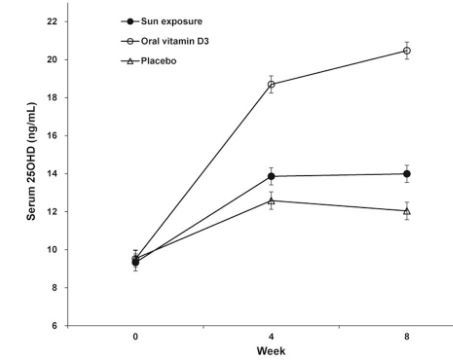25 minutes of daily sun provided less than half of the response as 500 IU of vitamin D (Korea) – RCT
Effect of sun exposure versus oral vitamin D supplementation on serum 25-hydroxyvitamin D concentrations in young adults: A randomized clinical trial
Hee-Kyung Joha,b,c, Hee-Kyung Joh Hee-Kyung Joh, Hwang Seung-sikd, Be Long Chob,e,f,g, Chun Soo Limh, Sung-Eun Jungi
DOI: https://doi.org/10.1016/j.clnu.2019.03.021
📄 Download the PDF from Sci-Hub via VitaminDWiki
Sun was only slightly better than placebo

Background
Vitamin D inadequacy is associated with a wide range of diseases. However, optimal strategies to improve vitamin D status, especially in Asian populations, remain unclear. We tested the hypotheses that (1) relevant sun exposure or oral vitamin D supplementation would significantly increase serum 25-hydroxyvitamin D (25OHD) concentrations compared with placebo, (2) sun exposure and supplementary vitamin D would be similar in serum 25OHD increases, and (3) the two interventions may have different effects on cardio-metabolic markers.
Methods
In this 8-week randomized placebo-controlled clinical trial including vitamin D-deficient adults in Seoul (37 °N), Korea, changes in serum 25OHD concentrations were compared between the sun exposure (daily ≥ 20–30 minutes around noon, n = 50), oral vitamin D3 (500 IU/d, n = 50), and control (placebo, n = 50) groups.
Results
Both sun exposure and oral vitamin D3 effectively increased serum 25OHD concentrations. Compared with placebo, the between-group least-squares mean (LSM) differences in changes were 2.2 ng/mL (95% CI: 0.2, 4.2) in the sun exposure group and 8.5 ng/mL (6.5, 10.5) in the oral vitamin D3 group. Increases in serum 25OHD were greater with oral vitamin D3 than with sun exposure (LSM difference in changes = 6.3 ng/mL, 95% CI: 4.3, 8.3). More participants in the oral vitamin D3 group (54.2%) achieved serum 25OHD concentrations ≥ 20 ng/mL at week 8 than those in the sun exposure (12.2%) or control (4.3%) groups. Compliance with sun exposure advice was relatively low , and only those with adequate compliance had a significant increase in serum 25OHD. Changes in the cardio-metabolic markers were mostly insignificant in all groups.
Conclusions
Enhanced sun exposure and 500 IU/d of oral vitamin D3 supplementation significantly increased serum 25OHD concentrations. However, our protocol for sun exposure was not as effective as 500 IU/d of oral vitamin D3 supplementation.
This trial was registered at clinicaltrials.gov as NCT03310242.
